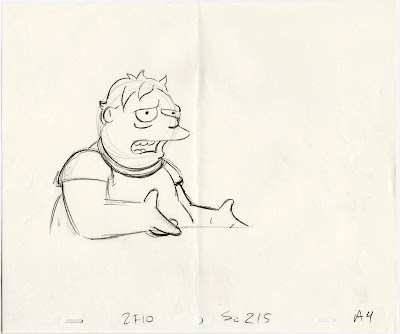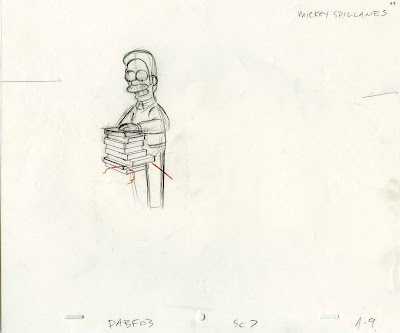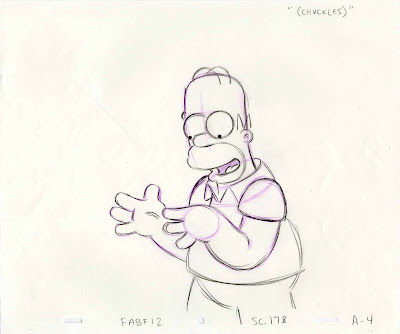Loved her look, and she oozed confidence. Very cool.
animated backgrounds ,for websites windows ,desktop backgrounds,flashing gif,art graphics,pictures,photo,image,icon,videos,
Tuesday, June 28, 2011
Monday, June 27, 2011
Friends from work
Just some fun drawings done for co-workers either as going-away gifts (sadface) or b-day gifts. Or just to make fun of them.
Pascal F.
AJ
Keith P.
Nathan E.
Sheldon & Chantelle
Joe Lee.
And so we're fair, here's a flattering one of me done by the awesomely talented and equally cruel, Garrett Shikuma
Saturday, June 25, 2011
Smears, Multiples and Other Animation Gimmicks
What a great little addition to the Blog Roll...found this blog that post smear frames from every type of animation out there. Blog was created by Michael J. Ruocco.
Enjoy
JP
found via cartoon brew
Enjoy
JP
found via cartoon brew
Thursday, June 23, 2011
AnimSchool Promotional Video is UP
Hey Everyone
David Gallagher..creator of AnimSchool has just released a new promotional video about the school. It seems better and better the more I see of it! You can also see a snip-it of the rig demo over at the 3D Appeal Blog, that shows off a bit of the rig....it looks AMAZING!! You can visit the AnimSchool site as well and check out everything you need to know about the school: pricing, class schedule and the instructors.
So head on over and check it out...looks like another great school!
Enjoy
JP
David Gallagher..creator of AnimSchool has just released a new promotional video about the school. It seems better and better the more I see of it! You can also see a snip-it of the rig demo over at the 3D Appeal Blog, that shows off a bit of the rig....it looks AMAZING!! You can visit the AnimSchool site as well and check out everything you need to know about the school: pricing, class schedule and the instructors.
So head on over and check it out...looks like another great school!
Enjoy
JP
Wednesday, June 22, 2011
On Vacation
There will (probably) be no updates to this blog for the next week or 10 days. See you soon.
Tyrus Wong at the Walt Disney Family Museum
 From left to right: Paul Felix (Disney animator), Tyrus Wong and Ralph Eggleston (Pixar art director)
From left to right: Paul Felix (Disney animator), Tyrus Wong and Ralph Eggleston (Pixar art director)Saturday, June 18, 2011
The Flying House: Resurrection or Ruination?
Independent animator Bill Plympton is using Kickstarter to raise money to "resurrect" Winsor McCay's 1921 short The Flying House. Plympton is digitally cleaning the film, colorizing it, replacing word balloons with audio dialogue and adding music and sound effects.
I am torn about this. On the one hand, the film is in the public domain. I personally think that copyright has become way too restrictive and that the public domain is a good thing for society at large, allowing past work to be re-issued and to inspire new work. What Plympton is attempting here is fully within the law and an example of how the public domain can feed contemporary creation.
On the other hand, the historian in me believes that the past has value and to remake the past is to distort it. I was always against colorization when it was applied to black and white films. I also believe that there is great value in attempting to understand the past by immersing yourself in it. The world was a different place socially, culturally and technologically, and understanding how the world has changed can only be accomplished by understanding how the past was different from the present.
I don't think I'd have a problem if Plympton decided to remake the film. Leaving the original alone and offering a new interpretation of a past work is something people have been doing throughout recorded history. Restoration has always been focused on returning a work to its original state. This is a posthumous collaboration. Because film is mechanically reproduced, the original is untouched, but is this something like changing the background behind Mona Lisa or revising Duchamp's painting so that it is Nude Ascending a Staircase?
It's not fair of me to judge an unfinished work as it's impossible for me to come to a conclusion, but the project does raise questions.
Friday, June 17, 2011
Marjane Satrapi on Making a Film From Comics
 Marjane Satrapi, author of Persepolis and the co-director of the animated version, gives her thoughts on making a film from comics.
Marjane Satrapi, author of Persepolis and the co-director of the animated version, gives her thoughts on making a film from comics."Animation and comics are false siblings. They resemble one another but they're two completely different things. The relationship a reader has with a comic is nothing like the one a viewer has with a film. When you read a comic, you're always active, because you have to imagine all the movements that happen between the frames. In a film, you are passive: all the information is there. And when you make a comic it never happens that you have 500 or 1,000 people reading it in the same place at the same time, all reacting. The language of cinema and comics is different, even though they both use images. In comics, you write with images; they're like pictograms. And in a movie you think about movement and sound and music, all those things that are not considerations when making comics."
Wednesday, June 15, 2011
The Elements of a Scene: Character Arc
This is the sixth in a series analyzing a scene from The Grapes of Wrath. This entry is about character arc.
People change. They change as they age and as they experience new things. In drama, the conflict is a crucible for altering the main character's view of the world and him- or herself.
Using Casablanca as an example, the Humphrey Bogart character starts out emotionally dead due to a failed love affair. His past political activities and his way of relating to others have both been frozen. When he is forced to confront his lost love, he undergoes a painful transformation. By the end of the film, he is once more alive emotionally and committed politically. The thaw that takes place over the course of the story is the Bogart character's arc.
As John Truby writes in The Anatomy of Story,
“Drama is a code of maturity. The focal point is the moment of change, the impact, when a person breaks free of habits and weaknesses and ghosts from his past and transforms to a richer and fuller self. The dramatic code expresses the idea that human beings can become a better version of themselves, psychologically and morally. And that’s why people love it.”Sometimes, the inability to change is the point of the story. If you are familiar with the film From Here to Eternity (based on the novel by James Jones, screenplay by Daniel Taradash and directed by Fred Zinnemann), the three main characters, played by Burt Lancaster, Montgomery Clift and Frank Sinatra, are all incapable of change. As a result, each loses something due to their unwillingness to bend.
Within the larger film of The Grapes of Wrath, the main character arc is that of Tom Joad, played by Henry Fonda. Over the course of the film he is exposed to how his family and people like them are treated. As a result, he goes from being concerned only with his family to a larger class consciousness.
In the scene above, the protagonist is Pa Joad, trying to buy a loaf of bread. But he has no character arc. He leaves the scene with the same mindset as when he entered it. The arcs in this scene belong to the antagonist, the waitress, and also to the truck drivers. She starts out resisting Pa's request and slowly awakens to the Joads' situation as she hears Pa's explanations and sees the children staring at the candy. Like Tom in the larger story, she achieves something of a class consciousness as a result of her encounter.
The same can be said of the truck drivers. They start out resolutely neutral, saying nothing during the conversation between Pa and the waitress. After the waitress lies about the cost of the candy so that the Joads can afford it, the truckers are also moved to declare their solidarity with what's gone on by refusing their change.
Character arc is a problem when it comes to characters who are part of a series. An arc implies a change of worldview, yet a series character can't change without losing the very qualities that make the character popular in the first place. Homer Simpson can never wise up. Regardless of what he might learn in an episode, he has to forget it by the start of the next if he's to stay Homer Simpson. No real person could live Homer Simpson's life without getting smarter or getting killed.
But if a story is self contained, a character's change or lack of it is the whole point.
Tuesday, June 14, 2011
The Simpsons (TV Series 1989– ) - Production Drawings
Subscribe to:
Posts (Atom)









 Animation Smears
Animation Smears










































































































































































































































































































































































